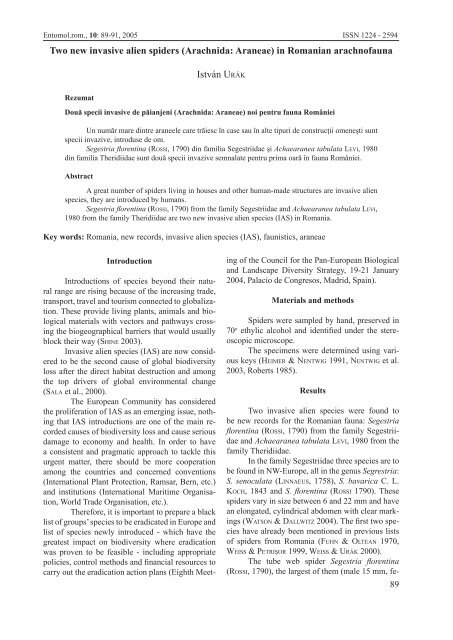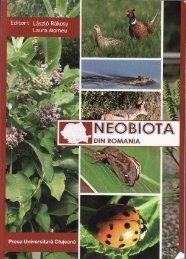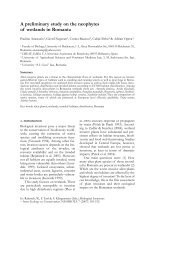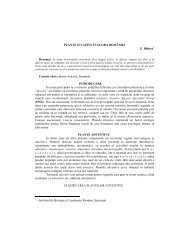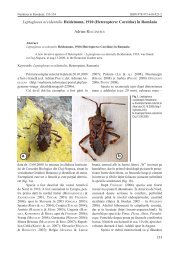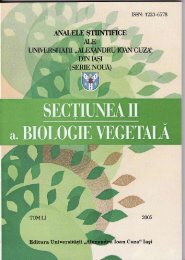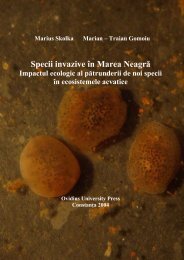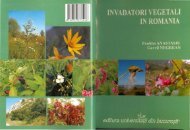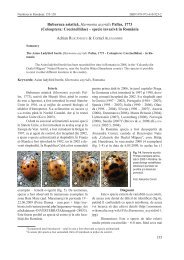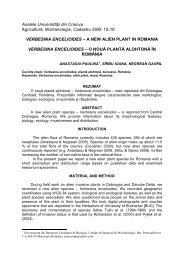Two new invasive alien spiders (Arachnida: Araneae) in Romanian ...
Two new invasive alien spiders (Arachnida: Araneae) in Romanian ...
Two new invasive alien spiders (Arachnida: Araneae) in Romanian ...
Create successful ePaper yourself
Turn your PDF publications into a flip-book with our unique Google optimized e-Paper software.
Entomol.rom., 10: 89-91, 2005 ISSN 1224 - 2594<strong>Two</strong> <strong>new</strong> <strong><strong>in</strong>vasive</strong> <strong>alien</strong> <strong>spiders</strong> (<strong>Arachnida</strong>: <strong>Araneae</strong>) <strong>in</strong> <strong>Romanian</strong> arachnofaunaIstván UrákRezumatDouă specii <strong><strong>in</strong>vasive</strong> de păianjeni (<strong>Arachnida</strong>: <strong>Araneae</strong>) noi pentru fauna RomânieiUn număr mare d<strong>in</strong>tre araneele care trăiesc în case sau în alte tipuri de construcţii omeneşti suntspecii <strong>in</strong>vazive, <strong>in</strong>troduse de om.Segestria florent<strong>in</strong>a (Rossi, 1790) d<strong>in</strong> familia Segestriidae şi Achaearanea tabulata Levi, 1980d<strong>in</strong> familia Theridiidae sunt două specii <strong>in</strong>vazive semnalate pentru prima oară în fauna României.AbstractA great number of <strong>spiders</strong> liv<strong>in</strong>g <strong>in</strong> houses and other human-made structures are <strong><strong>in</strong>vasive</strong> <strong>alien</strong>species, they are <strong>in</strong>troduced by humans.Segestria florent<strong>in</strong>a (Rossi, 1790) from the family Segestriidae and Achaearanea tabulata Levi,1980 from the family Theridiidae are two <strong>new</strong> <strong><strong>in</strong>vasive</strong> <strong>alien</strong> species (IAS) <strong>in</strong> Romania.Key words: Romania, <strong>new</strong> records, <strong><strong>in</strong>vasive</strong> <strong>alien</strong> species (IAS), faunistics, araneaeIntroductionIntroductions of species beyond their naturalrange are ris<strong>in</strong>g because of the <strong>in</strong>creas<strong>in</strong>g trade,transport, travel and tourism connected to globalization.These provide liv<strong>in</strong>g plants, animals and biologicalmaterials with vectors and pathways cross<strong>in</strong>gthe biogeographical barriers that would usuallyblock their way (Sh<strong>in</strong>e 2003).Invasive <strong>alien</strong> species (IAS) are now consideredto be the second cause of global biodiversityloss after the direct habitat destruction and amongthe top drivers of global environmental change(Sala et al., 2000).The European Community has consideredthe proliferation of IAS as an emerg<strong>in</strong>g issue, noth<strong>in</strong>gthat IAS <strong>in</strong>troductions are one of the ma<strong>in</strong> recordedcauses of biodiversity loss and cause seriousdamage to economy and health. In order to havea consistent and pragmatic approach to tackle thisurgent matter, there should be more cooperationamong the countries and concerned conventions(International Plant Protection, Ramsar, Bern, etc.)and <strong>in</strong>stitutions (International Maritime Organisation,World Trade Organisation, etc.).Therefore, it is important to prepare a blacklist of groups’ species to be eradicated <strong>in</strong> Europe andlist of species <strong>new</strong>ly <strong>in</strong>troduced - which have thegreatest impact on biodiversity where eradicationwas proven to be feasible - <strong>in</strong>clud<strong>in</strong>g appropriatepolicies, control methods and f<strong>in</strong>ancial resources tocarry out the eradication action plans (Eighth Meet<strong>in</strong>gof the Council for the Pan-European Biologicaland Landscape Diversity Strategy, 19-21 January2004, Palacio de Congresos, Madrid, Spa<strong>in</strong>).Materials and methodsSpiders were sampled by hand, preserved <strong>in</strong>70 o ethylic alcohol and identified under the stereoscopicmicroscope.The specimens were determ<strong>in</strong>ed us<strong>in</strong>g variouskeys (Heimer & Nentwig 1991, Nentwig et al.2003, Roberts 1985).Results<strong>Two</strong> <strong><strong>in</strong>vasive</strong> <strong>alien</strong> species were found tobe <strong>new</strong> records for the <strong>Romanian</strong> fauna: Segestriaflorent<strong>in</strong>a (Rossi, 1790) from the family Segestriidaeand Achaearanea tabulata Levi, 1980 from thefamily Theridiidae.In the family Segestriidae three species are tobe found <strong>in</strong> NW-Europe, all <strong>in</strong> the genus Segrestria:S. senoculata (L<strong>in</strong>naeus, 1758), S. bavarica C. L.Koch, 1843 and S. florent<strong>in</strong>a (Rossi 1790). These<strong>spiders</strong> vary <strong>in</strong> size between 6 and 22 mm and havean elongated, cyl<strong>in</strong>drical abdomen with clear mark<strong>in</strong>gs(Watson & Dallwitz 2004). The first two specieshave already been mentioned <strong>in</strong> previous listsof <strong>spiders</strong> from Romania (Fuhn & Oltean 1970,Weiss & Petrişor 1999, Weiss & Urák 2000).The tube web spider Segestria florent<strong>in</strong>a(Rossi, 1790), the largest of them (male 15 mm, fe-89
male 22 mm) can be found <strong>in</strong> the warmer regions ofEurope and Southern-England. It has been recordedrecently <strong>in</strong> Hungary, <strong>in</strong> urban area of Szeged (Kovács& Sz<strong>in</strong>etár 2004). We collected an adult malespecimen <strong>in</strong> 2004, <strong>in</strong> Cluj-Napoca (leg. CiliboaieC.). In the storehouse where this species was captured,goods from France were stored. This is theway the specimen was probably <strong>in</strong>troduced.This species is usually black with some lightermark<strong>in</strong>gs on the abdomen. It is active at night andit can be seen at the entrance of its tube web. It hasgreen iridescent jaws that reflect the light of a torchif you flash <strong>in</strong>to a tube web. The female lays eggs <strong>in</strong>her tube web and stays until the young have hatchedand dispersed. Sometimes the female dies and heryoung eat her (Nieuwenhuys, 2005).These <strong>in</strong>terest<strong>in</strong>g <strong>spiders</strong> make a tube shapedweb <strong>in</strong> old walls. At the open<strong>in</strong>g of the tube, six ormore l<strong>in</strong>es of silk radiate <strong>in</strong> all directions and thespider sits with six of its legs touch<strong>in</strong>g the l<strong>in</strong>es ofsilk. If an <strong>in</strong>sect crosses one of these l<strong>in</strong>es the spiderrushes out of the tube, catches the <strong>in</strong>sect and rushesback <strong>in</strong>to the tube web where it eats the <strong>in</strong>sect <strong>in</strong>safety.Its venom ma<strong>in</strong>ly reduces the rate and amountof sodium <strong>in</strong>activation. This effect is likely to beresponsible for the prolongation of the action potential(Usmanov et al. 1985).The Theridiidae or comb-footed <strong>spiders</strong> is alarge and diverse family. They have comb or serratedsetae (hairs) on the h<strong>in</strong>d tarsi. The dangerousblack widow (Latrodectus mactans) belongs to thisfamily and these <strong>spiders</strong> are notorious for their verypoisonous venom. Some species of this family arecommon <strong>in</strong> garden and characteristic of houses andother human-made build<strong>in</strong>gs. Many of them are <strong><strong>in</strong>vasive</strong>.Achaearanea tabulata Levi, 1980 knownfrom New York (North America) and from the FarEast (Japan and Korea) (Levi 1980, Yoshida 1983),were recorded <strong>in</strong> 1988 <strong>in</strong> the urban area of Berl<strong>in</strong>(Germany) as a <strong>new</strong> species for Europe (Moritz etal. 1988). In 1990 was found <strong>in</strong> urban habitats ofInnsbruck (Austria) <strong>in</strong> both sexes (Knoflach 1991).In Romania two females of this species were recorded<strong>in</strong> 2001, <strong>in</strong> rural area of village Căpeni, <strong>in</strong>cellar (leg. Tompos G.).The orig<strong>in</strong>al source of A. tabulata is unknown.The spider has probably been <strong>in</strong>troduced<strong>in</strong>to both North America and Europe, given the stateof knowledge of the Theridiidae on both cont<strong>in</strong>ents.They may orig<strong>in</strong>ate from Japan and Korea, but thesource could be some other country or countries <strong>in</strong>Southeast Asia. It is likewise difficult to predict theactual range of A. tabulata; the spider may occurmore widely than we know, ow<strong>in</strong>g to its similarityto A. tepidariorum (Dondale et al. 1994).Adults of A. tabulata resemble very muchthose of A. tepidariorum <strong>in</strong> their general look,choice of web site and orientation with<strong>in</strong> the web.They differ from the latter <strong>in</strong> be<strong>in</strong>g smaller anddarker, and <strong>in</strong> the external genitalia. Concern<strong>in</strong>gtheir measured characters, female samples overlap<strong>in</strong> range except for their total body length. Similarmale samples showed no overlap concern<strong>in</strong>g theirbasitarsus length, but the other characters were statisticallydifferent at the 0.1 level of significance(Dondale et al. 1994).A peculiar retreat made by large juvenilesand by females of tabulata has been observed anddescribed by Yoshida (1983), Moritz et al. (1988),Knoflach (1991), and Dondale et al. (1994). Thefemales are often found <strong>in</strong>side their retreat, sometimeswith one or more males <strong>in</strong> close proximity.Later, the egg sac or sacs are placed there. No suchretreat has been reported for tepidariorum (Dondaleet al. 1994).ConclusionsThere is only an extremely small amount ofknowledge about synanthropic <strong>spiders</strong> and <strong><strong>in</strong>vasive</strong><strong>alien</strong> species <strong>in</strong> Romania. The <strong>spiders</strong> presented <strong>in</strong>this paper are not considered as a problematic speciesyet.The <strong>new</strong> records of this species widen our<strong>in</strong>formation concern<strong>in</strong>g their distribution <strong>in</strong> Europe.The studies about synanthropic <strong>spiders</strong> liv<strong>in</strong>g<strong>in</strong> houses and other human-made build<strong>in</strong>gs are extremelysignificant. They can provide essential <strong>in</strong>formationabout this species, their potential impactson humans and different native populations.AknowledgmentsWe thank Gábor Tompos and Căl<strong>in</strong> Ciliboaiefor the provided arahnological material and FerencSamu for his review of these species.The preparation of the article was supportedby a research grant from the Hungarian M<strong>in</strong>istry ofSciences – Domus Hungarica Scientiarium and Artium.ReferencesDondale Ch. D., Redner H .J., LeSage L. 1994. Acomb-footed spider Achaearanea tabulata, <strong>new</strong>to the fauna of Canada (<strong>Araneae</strong>: Theridiidae).The Journal of Arachnology 22: 176–178.90
Fuhn I. E., Oltean C. 1970. Lista Araneelor d<strong>in</strong> R.S.Romania. Stud. Com., Muz. St. Nat. Bacău:157-196. Bacău.Heimer S. & Nentwig W. 1991. Sp<strong>in</strong>nen Mitteleuropas.Paul Parey Verlag, Berl<strong>in</strong> und Hamburg.Knoflach B. 1991. Achaearanea tabulata Levi, e<strong>in</strong>efür Österreich neue Kugelsp<strong>in</strong>ne (<strong>Arachnida</strong>,Aranei: Theridiidae). Ber. nat.-med. Vere<strong>in</strong>Innsbruck 78: 59-64.Levi H. W. 1980. <strong>Two</strong> <strong>new</strong> <strong>spiders</strong> of the generaTheridon and Achaearanea from North America(<strong>Araneae</strong>: Theridiidae). Trans. amer. micros.Soc., 99: 334-337.Moritz M., Lewi H. W., Pfüller R. 1988. Achaearaneatabulata, e<strong>in</strong>e für Europa neue Kugelsp<strong>in</strong>ne(<strong>Araneae</strong>, Theridiidae). Dtsch. ent. Z. NF, 36:361-367.Nentwig W., Hänggi A., Kropf C., Blick T. 2003.Sp<strong>in</strong>nen Mitteleuropas (Bestimmungsschlüssel).Version 8. Internet: http://www.araneae.unibe.ch.Nieuwenhuys E. 2005. <strong>Araneae</strong>, Spiders of North-West Europe. http://www.xs4all.nl/~edniew/Spiders/spidhome.htm.Roberts M. I. 1985. The <strong>spiders</strong> of Great Brita<strong>in</strong> andIreland. Volume 1. Harper Coll<strong>in</strong>s, London.Sala O. E., Chap<strong>in</strong> F. S. III, Armesto J. J., BerlowR., Bloomfield J., Dirzo R., Huber-SanwaldE., Huenneke L. F., Jackson R. B., K<strong>in</strong>zig A.,Leemans R., Lodge D., Mooney H. A., OesterheldM., Poff N. L., Sykes M. T., Walker B.H., Walker M., Wall D. H. 2000. Global biodiversityscenarios for the year 2100. Science,287: 1770-1774.Sh<strong>in</strong>e C. 2003. Overview of the management of <strong><strong>in</strong>vasive</strong><strong>alien</strong> species from the environmental perspective.In: Identification of risks and managementof <strong><strong>in</strong>vasive</strong> <strong>alien</strong> species us<strong>in</strong>g the IPPCframework. 20-38.Usmanov P. B., Kalikulov D., Nasledov G. A., TashmukhamedovB. A. 1985. Effect of Segestriaflorent<strong>in</strong>a spider venom on the mechanism of<strong>in</strong>activation of sodium channels. Biofizika,30(4): 617-619.Watson L., Dallwitz M. J. 2004. The families of <strong>spiders</strong>represented <strong>in</strong> the British Isles. http://delta-<strong>in</strong>tkey.com/britsp/www/segestri.htm.Weiss I., Petrişor A. 1999. List of the <strong>spiders</strong> (<strong>Arachnida</strong>:<strong>Araneae</strong>) From Romania. Trav. Mus. natl.Hist. nat. “Grigore Antipa”, 41: 79-107.Weiss I., Urák I. 2000. Faunenliste der Sp<strong>in</strong>nenRumäniens (<strong>Arachnida</strong>: <strong>Araneae</strong>). Internet:http://members.aol.com/Arachnologie/Faunenlisten.htm.Yoshida H. 1983. A <strong>new</strong> species of the genus Achaearanea(<strong>Araneae</strong>: Theridiidae) from Japan. Actaarachn. Tokyo 32: 37-42.István UrákUniversitatea Sapientia,Facultatea de Şti<strong>in</strong>ţe şi ArteStr. Matei Corv<strong>in</strong> Nr. 4,Ro - 400112 Cluj-Napoca,e-mail: istvan.urak@milvus.roReceived: 15.12.2005Accepted: 25.12.2005Pr<strong>in</strong>ted: 28.12.200591


